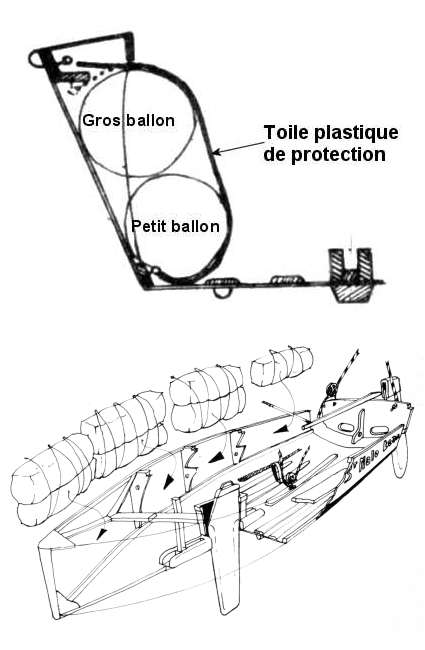| En voilà un sujet qui interpelle ! Avoir des réserves de flottabilité en quantité suffisante, c'est l'assurance (le cas de le dire...) de ne pas prendre de risque, et de pouvoir repartir facilement, après un dessalage, avec un bateau suffisamment vide d'eau...INDISPENSABLE pour tous les bateaux sans caissons ! | |
 |
Les réserves de flottabilitéLe croquis ci-contre représente l'idéal des idéaux : à savoir l'intégralité de l'intérieur de la coque "tapissée" de ballons simples ou doubles. L'ensemble est ficelé et fixé à l'aide de pontets vissés dans la structure du bateau. |
| A ce sujet, voici le texte initial définissant les règles en la matière : |
|
|
XII. - Sécurité - Flottabilité
Chaque bateau doit comporter un caisson étanche à l'avant, conforme au plan, et un bloc de plastique expansé selon les cotes du plan n° 13 fixé solidement sous chaque banc. Ce dispositif peut être remplacé par des volumes de flottabilité répartis de la façon suivante : 168 dm3 minimum obligatoires dont au moins 40 dm3 sous chaque banc et 80 dm3 sous le pontage avant (1).(extrait de "La bonne conduite du VAURIEN" - JJ Herbulot - Janvier 1970) |
|
... et voici maintenant le texte actuellement en vigueur : |
|
| 2.4.4 Owner's Responsibility It is the owner's responsibility to ensure that his boat complies with the class rules at all times and that replacements, alterations or repairs do not invalidate its Certificate. Replacements or alterations to the hull, centreboard and rudder, spars and sails shall be measured by an official measurer. |
|
|
3.1.11.1 Buoyancy apparatus (i) The built-in compartments shall be not less than three, the smallest having a volume of not less than 0,1 cubic metre. They shall be distribute along the hull so as to float the boat approximately level when capsized and/or full of water. 3.1.11.4 Secondary Buoyancy If the boat structure is not inherently buoyant, at least 0,1 cubic metre of the primary buoyancy shall be in the form of rigid foam (secondary buoyancy). This secondary buoyancy shall be divided up into not less than three approximately equal volumes and securely attached to the hull, one forward of the mast and the other two aft of the mast, and distributed equally on each side of the boat's centreline. (extrait de la Jauge Internationale Officielle - CIV / ISAF 1997...2007) |
|
D'après vous, quelle est la raison d'un tel durcissement de la règle ? ... |
|
